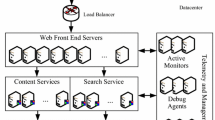Abstract
IT service trending of root causes of service incidents and problems is an important part of proactive problem management and service improvement. This exploratory case study focuses on exploring human errors as root causes in IT service incidents. In the case study, we applied Human Factors Analysis and Classification System (HFACS) analyzing 65 incidents to related IT services, like servers, network, storage, and applications.
Based on the analysis, several improvement suggestions were identified in IT service management processes of case organizations, including improvements in incident investigation process, coupling incident investigation to continual service improvement, and need for an HFACS taxonomy adapted to IT service management (ITSM), which helps in identifying trends in incidents.
Access this chapter
Tax calculation will be finalised at checkout
Purchases are for personal use only
Preview
Unable to display preview. Download preview PDF.
Similar content being viewed by others
References
ISO/IEC 20000-1:2011, Information technology – Service management – Part 1: Service management system requirements (2013)
Office, C.: ITIL Service Operation. The Stationary Office, UK (2011)
Office, C.: ITIL Continual Service Improvement. The Stationary Office, UK (2011)
ISO/IEC TC JTC1/ SC7 WG10: Information technology — Process assessment — Part 8: An exemplar process assessment model for IT service management, s.29 Geneva, Switzerland (2012)
Reason, J.: Human Error. Cambridge University Press, New York (1990)
Harris, D., Li, W.C.: An extension of the human factors analysis and classification system for use in open systems. Theoretical Issues in Ergonomics Science 12(2), 108–128 (2011)
Shappell, S., Wiegmann, D.: The Human Factors Analysis and Classification System—HFACS. US Department of Transportation (2000)
Saarelainen, K., Jäntti, M.: Human errors in IT services - HFACS model in root cause categorization. In: CIMT 2015: International Conference on Information and Multimedia Technology, Venice, Italy (2015)
Department of Defense Human Factors Analysis and Classification System - A mishap investigation and data analysis tool (2005)
Olsen, N.S., Shorrock, S.T.: Evaluation of the HFACS-ADF safety classification system: inter-coder consensus and intra-coder consistency. Accident Analysis and Prevention 42(2), 437–444 (2010)
Bilbro, J.: An inter-rater comparison of DoD human factors analysis and classification system (HFACS) and human factors analysis and classification system—maritime (HFACS-M) classification system. Naval Postgraduate School, Monterey (2013)
Schroder-Hinrichs, J.U., Baldauf, M., Ghirxi, K.: Accident investigation reporting deficiencies related to organizational factors in machinery space fires and explosions. Accident Analysis and Prevention 43(3), 1187–1196 (2011)
Patterson, J.M., Shappell, S.A.: Operator error and system deficiencies: Analysis of 508 mining incidents and accidents from Queensland. Australia using HFACS. Accident Analysis and Prevention 42, 1379–1385 (2010)
Pounds, J., Scarborough, A., Shappell, S.: A human factors analysis of air traffic control operational errors. Aviation Space and Environmental Medicine 71, 329–332 (2000)
Hsiao, Y., Drury, C., Wu, C., Paquet, V.: Predictive models of safety based on audit findings: Part 1: Model development and reliability. Applied Ergonomics 44, 261–273 (2013)
ElBardissi, A.W., Wiegmann, D.A., Dearani, J.A., Daly, R.C., Sundt, T.M.: Application of the human factors analysis and classification system methodology to the cardiovascular surgery operating room. Annals of Thoracic Surgery 83(4), 1412–1419 (2007)
Krulak, D.C.: Human factors in maintenance: impact on aircraft mishap frequency and severity. Aviation Space and Environmental Medicine 75(5), 429–432 (2004)
Cintron, R.: Human Factors Analysis and Classification System Interrater Reliability for Biopharmaceutical Manufacturing Investigations. Ph.D. Dissertation, Walden University (2015)
Reinach, S., Viale, A.: Application of a human error framework to conduct train accident/incident investigations. Accident Analysis and Prevention 38(2), 396–406 (2006)
Yin, R.: Case Study Research: Design and Methods. Sage Publishing, Beverly Hills (1994)
Baskerville, R.: Investigating Information Systems with Action Research. Communications of the Association for Information Systems 2, Article 19 (1999)
Helms Mills, J., Dye, K., Mills, A.J.: Understanding Organizational Change. Routledge, London (2009)
Dechy, N., et al.: Guidelines for Safety Investigations of Accidents. ESReDA - European Safety Reliability and Data Association, p. 12 (June 2009)
Risktec: Six Steps for Successful Incident Investigation. RISKworld issue 14 autumn 2008 pg 6, Warrington, United Kingdom (2008)
Serious Accident Investigation Chief Investigator’s Handbook Blm Manual H-1112-3. Bureau of Land Management, USA (2003)
ISO/IEC ISO/IEC TS 15504-8:2012(E): Software Engineering - Process Assessment - Part 8: An Exemplar Process Assessment Model for IT Service Management (2012)
Author information
Authors and Affiliations
Corresponding author
Editor information
Editors and Affiliations
Rights and permissions
Copyright information
© 2015 Springer International Publishing Switzerland
About this paper
Cite this paper
Saarelainen, K., Jäntti, M. (2015). A Case Study on Improvement of Incident Investigation Process. In: O’Connor, R., Umay Akkaya, M., Kemaneci, K., Yilmaz, M., Poth, A., Messnarz, R. (eds) Systems, Software and Services Process Improvement. EuroSPI 2015. Communications in Computer and Information Science, vol 543. Springer, Cham. https://doi.org/10.1007/978-3-319-24647-5_2
Download citation
DOI: https://doi.org/10.1007/978-3-319-24647-5_2
Published:
Publisher Name: Springer, Cham
Print ISBN: 978-3-319-24646-8
Online ISBN: 978-3-319-24647-5
eBook Packages: Computer ScienceComputer Science (R0)




